Complete Solutions to Comprehension of chapter SUPERPOSITION AND STANDING WAVES of Class 11 book with complete answers and questions
| Class 11 | PHYSICS |
| Chapter | SUPERPOSITION AND STANDING WAVES |
| CENGAGE PHYSICS | Comprehension |
| Number Of Questions | 55 |
| Academic Year | 2023-24 |
A closed air column `32 cm` long is in resonance with a tuning fork . Another open air column of length `66 cm` is in resonance with another tuning fork . If the two forks produce `8 beats//s` when sounded together , find
the speed of sound in the air02:13View SolutionA tuning fork `A` is in resonance with an air column ` 32 cm` long and closed at one end . When the length of this column is increased by `1 cm`,it is in resonance with another fork `B`. When `A and B` are sounded together , they produce `40 "beats in" 5 s`. Find their frequencies .
02:39View SolutionA tube of a certain diameter and of length `48cm` is open at both ends. Its fundamental frequency is found to be `320 Hz`. The velocity of sound in air is `320 m//sec`. Estimate the diameter of the tube.
02:56View SolutionA tube of a certain diameter and of length `48cm` is open at both ends. Its fundamental frequency is found to be `320 Hz`. The velocity of sound in air is `320 m//sec`. Estimate the diameter of the tube.
02:56View SolutionA pipe of length 85 cm is closed from one end.Find the number of possible natural oscillations of air columm in the pipe whose frequencies lie bnelow 1250 Hz.The velocity of sound in air is 340 `m//s`.
01:43View SolutionThe number of possible natural oscillartions of air column in a pipe closed at one end of length 85 cm whose ferquences lie below 1250 Hz are (velocity of sound = 340 ms^(-1))`
03:30View SolutionIn the arrangement shown in Fig. 7.100 , mass can be hung from a string with a linear mass density of `2 xx 10^(-3) kg//m` that passes over a light pulley . The string is connected to a vibrator of frequency `700 Hz` and the length of the string between the vibrator and the pulley is `1 m`.

If the mass suspended is `16 kg` , then the number of loops formed in the string is02:06View SolutionIn the arrangement shown in Fig. 7.100 , mass can be hung from a string with a linear mass density of `2 xx 10^(-3) kg//m` that passes over a light pulley . The string is connected to a vibrator of frequency `700 Hz` and the length of the string between the vibrator and the pulley is `1 m`.

If the mass suspended is `16 kg` , then the number of loops formed in the string is02:06View SolutionIn the arrangement shown in Fig. 7.100 , mass can be hung from a string with a linear mass density of `2 xx 10^(-3) kg//m` that passes over a light pulley . The string is connected to a vibrator of frequency `700 Hz` and the length of the string between the vibrator and the pulley is `1 m`.
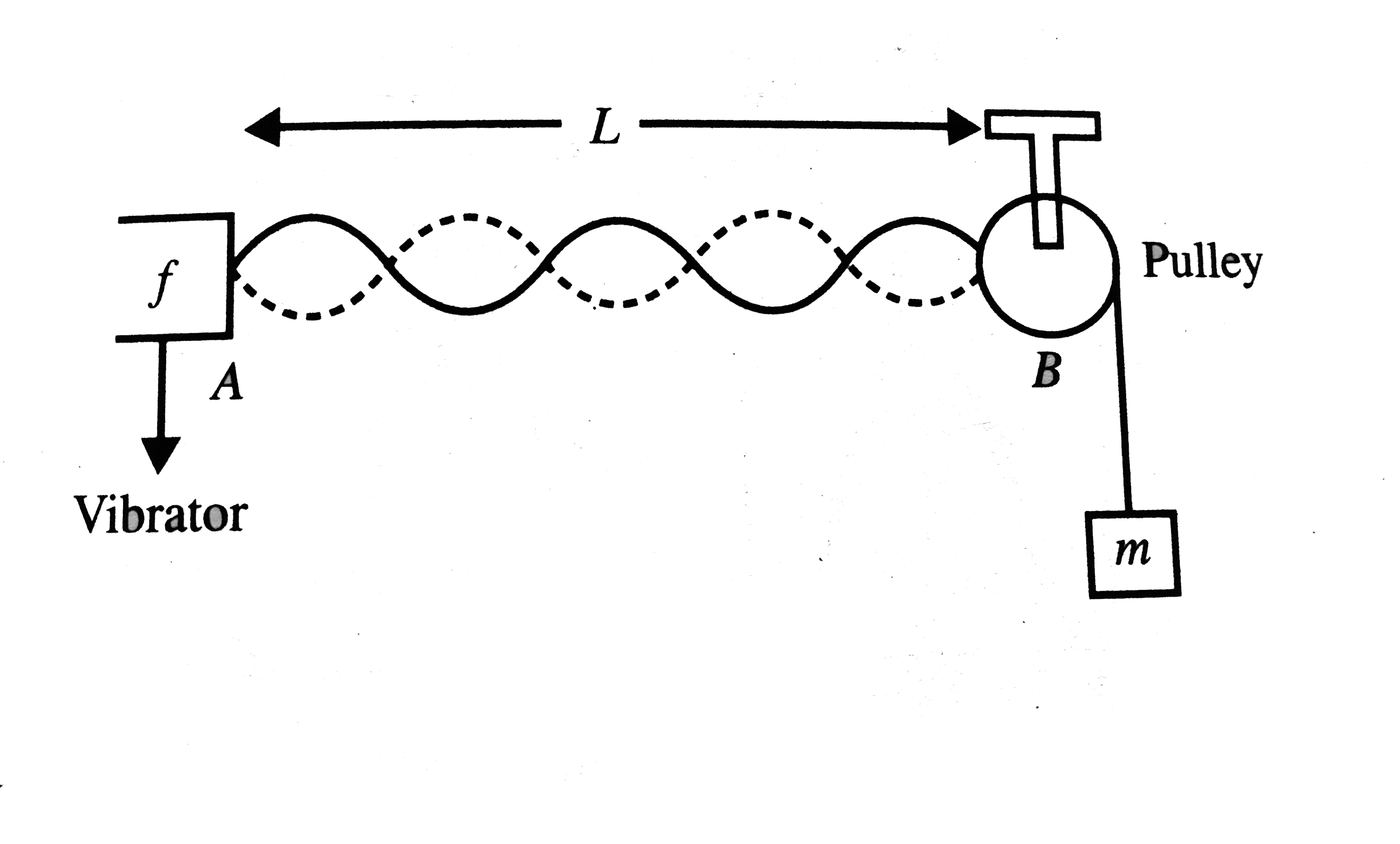
The string is set into vibrations and represented by the equation ` y = 6 sin (( pi x)/( 10)) cm cos (14 xx 10^(3) pi t)` where `x` ane `y` are in `cm` , and `t` in `s`, the maximum displacement at `x = 5 m` from the vibrator is01:31View SolutionBoth neon `[ M_(Ne) = 20 xx 10^(-3) kg]` and helium `[M_(He) = 4 xx 10^(-3) kg]` are monoatomic gases and can be assumed to be ideal gases. The fundamental frequency of a tube (open at both ends ) of neon is `300 Hz` at `270 K (R = ( 25//3) J//K mol)`
The length of the tube is02:19View SolutionBoth neon `[ M_(Ne) = 20 xx 10^(-3) kg]` and helium `[M_(He) = 4 xx 10^(-3) kg]` are monoatomic gases and can be assumed to be ideal gases. The fundamental frequency of a tube (open at both ends ) of neon is `300 Hz at 270 K (R = ( 25//3) J//K mol)`
The fundamental frequency of the tube if the tube is filled with helium , all other factors remaining the same is01:57View SolutionA long tube contains air pressure of `1 atm` and a temperature of `59^(@) C`. The tube is open at one end and closed at the other by a movable piston . A tuning fork near the open end is vibrating with a frequency of `500 Hz`. Resonance is produced when the piston is at distances `16 cm , 49.2 cm and 82.4 cm` from open end. Molar mass of air is `28.8 g//mol`.
The speed of sound in air at `59^(@) C` is02:43View SolutionA long tube contains air pressure of `1 atm` and a temperature of `59^(@) C`. The tube is open at one end and closed at the other by a movable piston . A tuning fork near the open end is vibrating with a frequency of `500 Hz`. Resonance is produced when the piston is at distances `16 cm , 49.2 cm and 82.4 cm` from open end. Molar mass of air is `28.8 g//mol`.
Ratio of heat capacities at constant pressure and constant volume for air at `59^(@) C` is02:39View SolutionA long tube contains air pressure of `1 atm` and a temperature of `59^(@) C`. The tube is open at one end and closed at the other by a movable piston . A tuning fork near the open end is vibrating with a frequency of `500 Hz`. Resonance is produced when the piston is at distances `16 cm , 49.2 cm and 82.4 cm` from open end. Molar mass of air is `28.8 g//mol`.
Radius of tube is03:37View SolutionA turning fork vibrating at `500 Hz` falls from rest accelerates at `10 m//s^(2)`.
Velocity of the tuning fork when waves with a frequency of `475 Hz` reach the release point is ( Take the speed of sound in air to be `340 m//s`).01:41View SolutionA turning fork vibrating at `500 Hz` falls from rest accelerates at `10 m//s^(2)`.
Time taken by the waves with a frequency of `475 Hz` to reach the release point is nearly03:51View SolutionA turning fork vibrating at `500 Hz` falls from rest accelerates at `10 m//s^(2)`.
How far below the point of release is the tuning fork when wave with a frequency of `475 Hz` reach the release point ?03:09View SolutionA long tube contains air at a pressure of `1 atm` and a temperature of `107^(@) C`. The tube is open at one end and closed at the other by a movable piston. A tuning fork near the open end is vibrating with a frequency of `500 Hz`. Resonance is produced when the piston is at distance `19 , 58.5 and 98 cm` from the open end.
The speed of sound at `10^(@) C` is02:31View SolutionA long tube contains air at a pressure of `1 atm` and a temperature of `107^(@) C`. The tube is open at one end and closed at the other by a movable piston. A tuning fork near the open end is vibrating with a frequency of `500 Hz`. Resonance is produced when the piston is at distance `19 , 58.5 and 98 cm` from the open end.
The molar mass of air is `28.8 g//mol`. The ratio of molar heat capacities at constant pressure and constant volume for air at this temperature is nearly02:53View SolutionA steel rod `2.5 m` long is rigidly clamped at its centre `C` and longitudinal waves are set up on both sides of `C` by rubbing along the rod . Young's modulus for steel ` = 2 xx 10^(11) N//m^(2)` , density of steel ` = 8000 kg//m^(3)`

If the clamp of the rod be shifted to its end `A` and totally four antinodes are observed in the rod when longitudinal waves are set up in it , the frequency of vibration of the rod in this mode is03:49View SolutionA steel rod `2.5 m` long is rigidly clamped at its centre `C` and longitudinal waves are set up on both sides of `C` by rubbing along the rod . Young's modulus for steel ` = 2 xx 10^(11) N//m^(2)` , density of steel ` = 8000 kg//m^(3)`

If the clamp of the rod be shifted to its end `A` and totally four antinodes are observed in the rod when longitudinal waves are set up in it , the frequency of vibration of the rod in this mode is03:49View SolutionA steel rod `2.5 m` long is rigidly clamped at its centre `C` and longitudinal waves are set up on both sides of `C` by rubbing along the rod . Young's modulus for steel ` = 2 xx 10^(11) N//m^(2)` , density of steel ` = 8000 kg//m^(3)`

If the clamp of the rod be shifted to its end `A` and totally four antinodes are observed in the rod when longitudinal waves are set up in it , the frequency of vibration of the rod in this mode is03:49View SolutionA longitudinal standing wave ` y = a cos kx cos omega t` is maintained in a homogeneious medium of density `rho`. Here `omega` is the angular speed and `k` , the wave number and `a` is the amplitude of the standing wave . This standing wave exists all over a given region of space.
The space density of the potential energy `PE = E_(p)(x , t)` at a point `(x , t)` in this space is04:05View SolutionA longitudinal standing wave ` y = a cos kx cos omega t` is maintained in a homogeneious medium of density `rho`. Here `omega` is the angular speed and `k` , the wave number and `a` is the amplitude of the standing wave . This standing wave exists all over a given region of space.
The space density of the kinetic energy . `KE = E_(k) ( x, t)` at the point `(x, t)` is given by02:51View SolutionA longitudinal standing wave ` y = a cos kx cos omega t` is maintained in a homogeneious medium of density `rho`. Here `omega` is the angular speed and `k` , the wave number and `a` is the amplitude of the standing wave . This standing wave exists all over a given region of space.
If a graph `E ( = E_(p) + E_(k))` versus `t` , i.e., total space energy density verus time were drawn at the instants of time `t = 0` and `t = T//4`, between two successive nodes separated by distance `lambda//2` which of the following graphs correctly shows the total energy `(E)` distribution at the two instants.09:01View SolutionIn a standing wave experiment , a `1.2 - kg` horizontal rope is fixed in place at its two ends `( x = 0 and x = 2.0 m)` and made to oscillate up and down in the fundamental mode , at frequency of `5.0 Hz`. At `t = 0` , the point at `x = 1.0 m` has zero displacement and is moving upward in the positive direction of `y - axis` with a transverse velocity `3.14 m//s`.
Tension in the rope is02:33View SolutionIn a standing wave experiment , a `1.2 - kg` horizontal rope is fixed in place at its two ends `( x = 0 and x = 2.0 m)` and made to oscillate up and down in the fundamental mode , at frequency of `5.0 Hz`. At `t = 0` , the point at `x = 1.0 m` has zero displacement and is moving upward in the positive direction of `y - axis` with a transverse velocity `3.14 m//s`.
Speed of the participating travelling wave on the rope is01:32View SolutionIn a standing wave experiment , a `1.2 - kg` horizontal rope is fixed in place at its two ends `( x = 0 and x = 2.0 m)` and made to oscillate up and down in the fundamental mode , at frequency of `5.0 Hz`. At `t = 0` , the point at `x = 1.0 m` has zero displacement and is moving upward in the positive direction of `y - axis` with a transverse velocity `3.14 m//s`.
What is the correct expression of the standing wave equation ?03:29View SolutionIn an organ pipe (may be closed or open ) of `99 cm` length standing wave is set up , whose equation is given by longitudinal displacement.
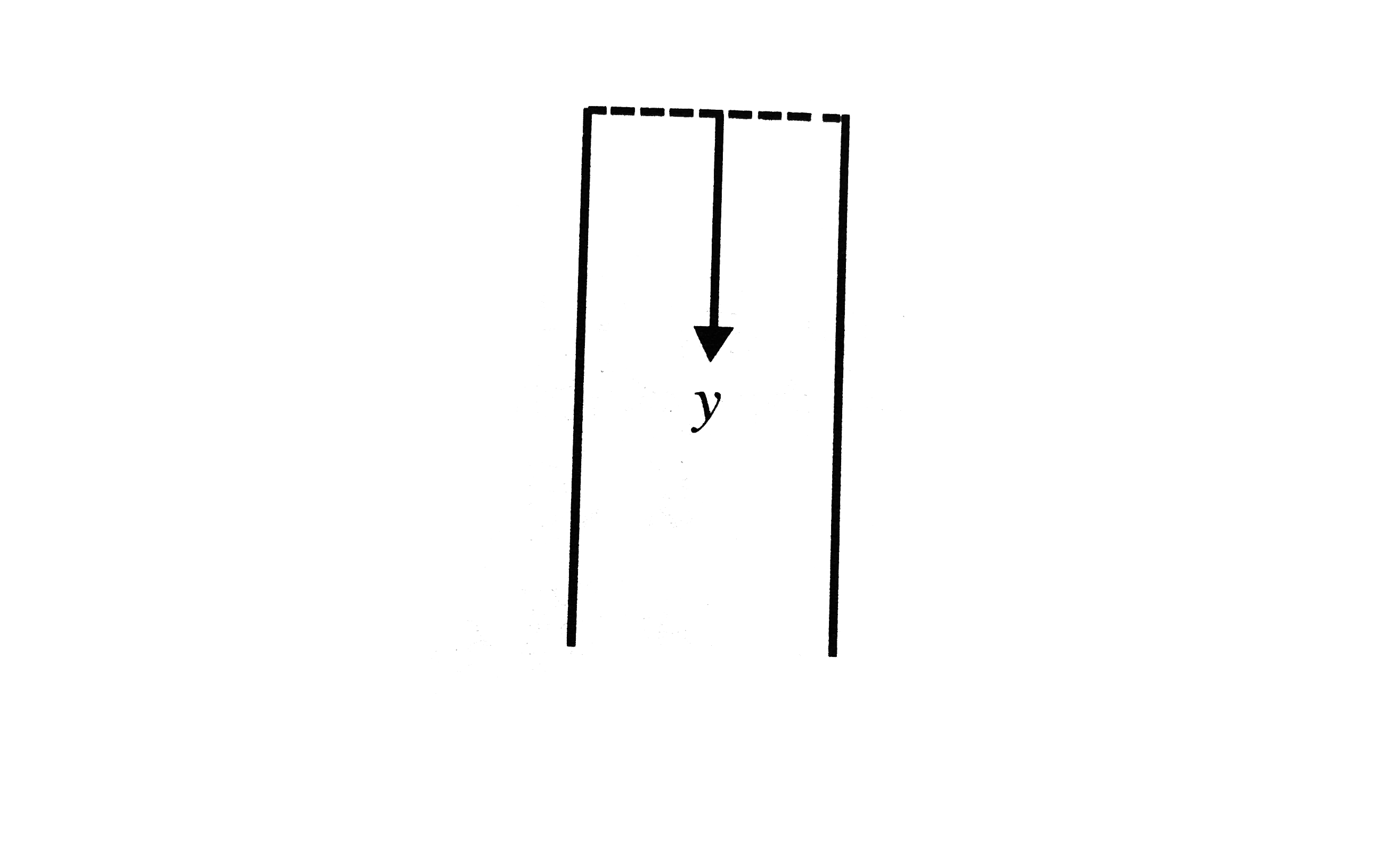
`xi = (0.1 mm) cos ( 2pi)/(0.8) (y + 1 cm) cos (400) t`where `y` is measured from the top of the tube in `metres` and `t "in" seconds` . Here `1 cm` is the end correction.
The upper end and the lower end of the tube are respectively .04:46View SolutionIn an organ pipe ( may be closed or open of `99 cm` length standing wave is setup , whose equation is given by longitudinal displacement `xi = (0.1 mm) cos ( 2pi)/( 0.8) ( y + 1 cm) cos 2 pi (400) t`
where `y` is measured from the top of the tube in metres and `t` in second. Here `1 cm` is th end correction.
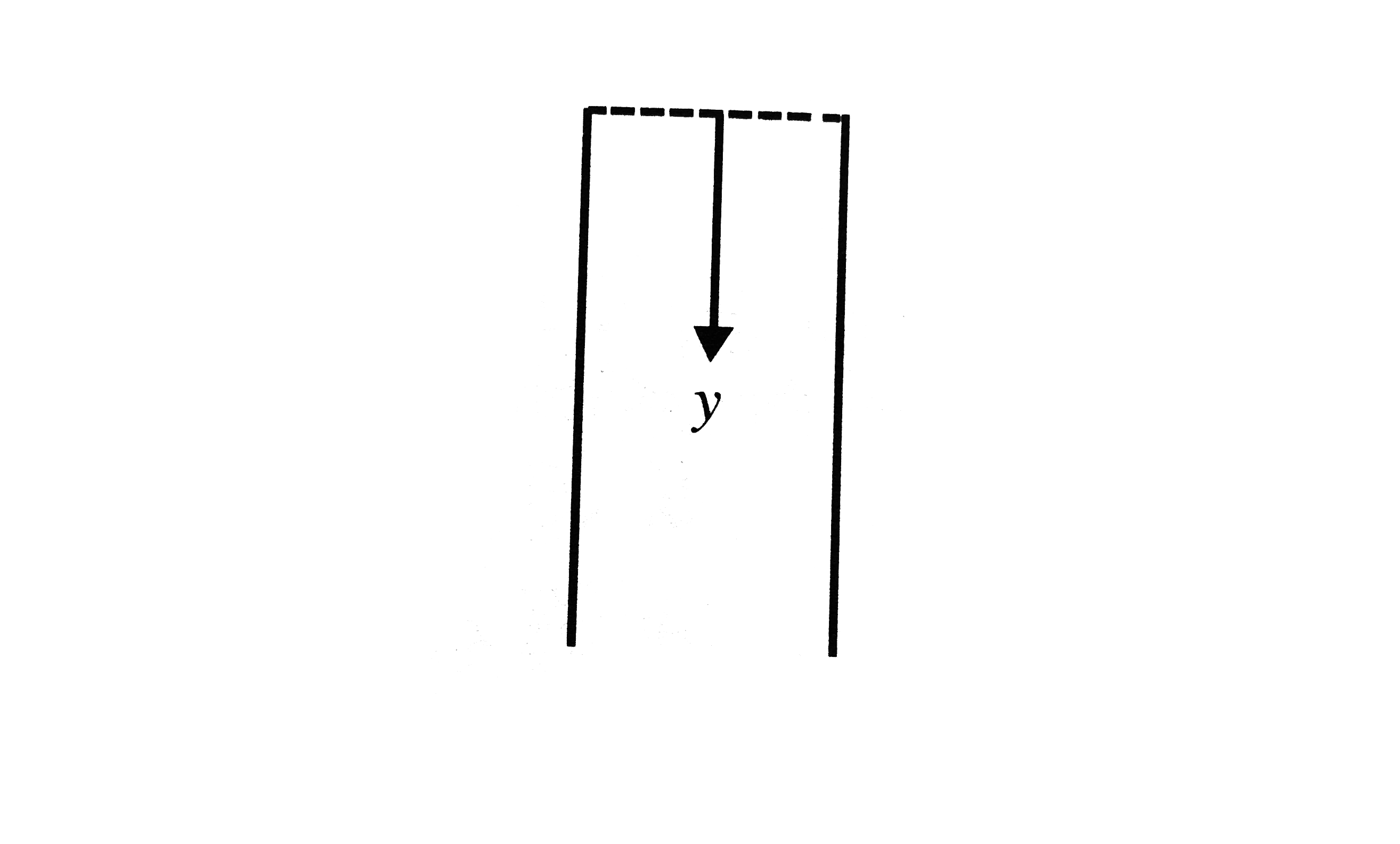
The air column is vibrating in03:11View SolutionIn an organ pipe (may be closed or open ) of `99 cm` length standing wave is set up , whose equation is given by longitudinal displacement.
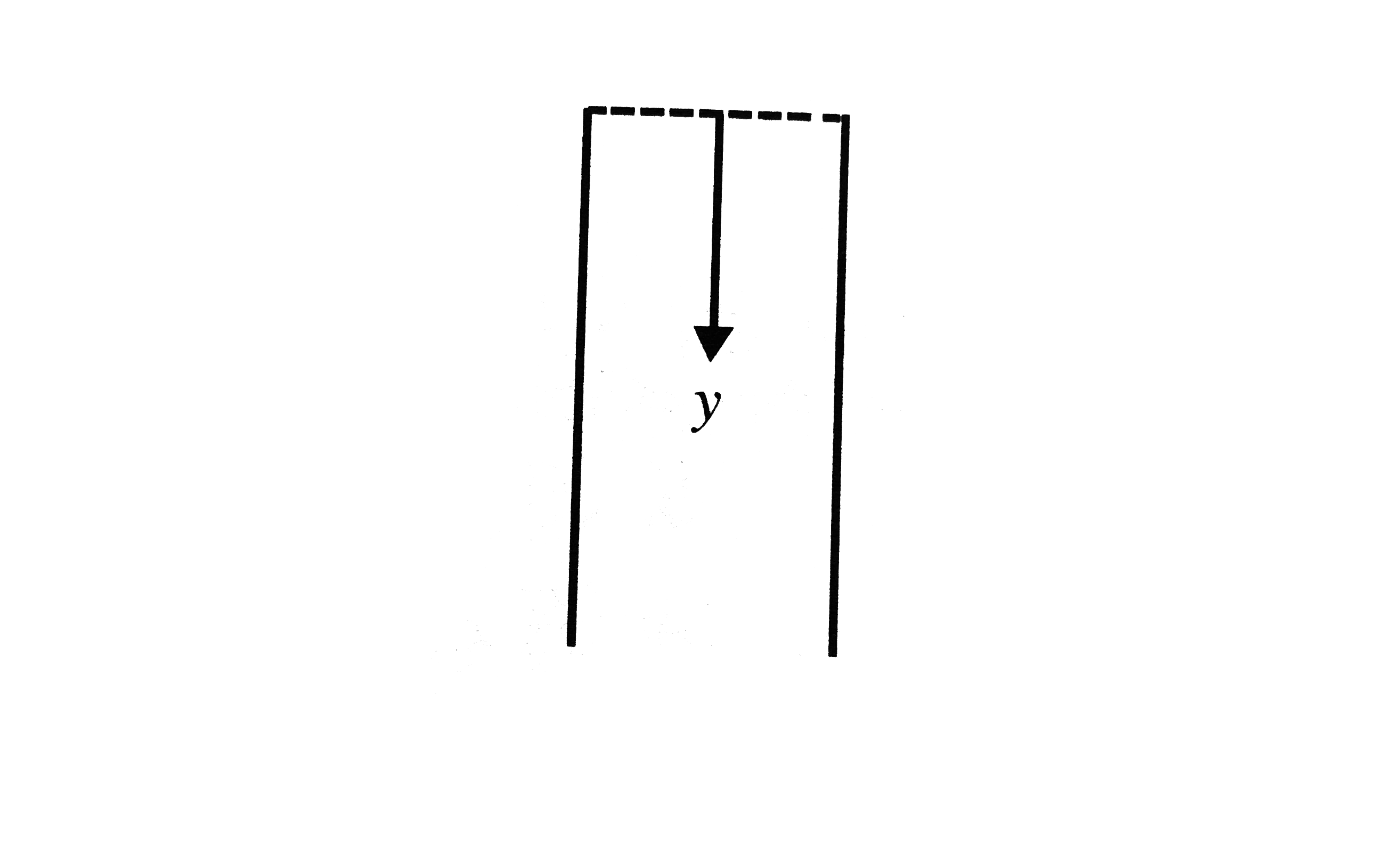
`xi = (0.1 mm) cos ( 2pi)/(0.8) (y + 1 cm) cos (400) t`where `y` is measured from the top of the tube in `metres` and `t "in" seconds` . Here `1 cm` is the end correction.
Equation of the standing wave in terms of excess pressure is ( take bulk modulus ` = 5 xx 10^(5) N//m^(2)`))05:43View SolutionEstimate the fraction of molecular volume to the actual volume occupied by oxygen gas at NTP. Take the diameter of an oxygen molecule to be `3Å`.
03:14View SolutionTwo plane harmonic sound waves are expressed by the equations.
`y_(1)(x,t)-A cos (0.5 pi x-100 pit), y_(2)(x,t)=A cos(0.46 pix-92pi t)` (All parameters are in MKS) :
How many times does an observer hear maximum intensity in one second :-02:35View SolutionTwo waves `y_(1) = A cos (0.5 pi x - 100 pi t)` and `y_(2) = A cos (0.46 pi x - 92 pi t)` are travelling in a pipe placed along the `x ` - axis.
Find wave velocity of louder sound01:10View SolutionTwo waves `y_(1) = A cos (0.5 pi x - 100 pi t)` and `y_(2) = A cos (0.46 pi x - 92 pi t)` are travelling in a pipe placed along the `x ` - axis.
Find wave velocity of louder sound01:10View SolutionAn oscillator of frequency `680 Hz` drives two speakers . The speakers are fixed on a vertical pole at a distance `3 m` from each other as shown in Fig. 7.103. A person whose height is almost the same as that of the lower speaker walks towards the lower speaker in a direction perpendicular to the pole. Assuming that there is no reflection of sound from the ground and speed of sound is `v = 340 m//s` , answer the following questions.
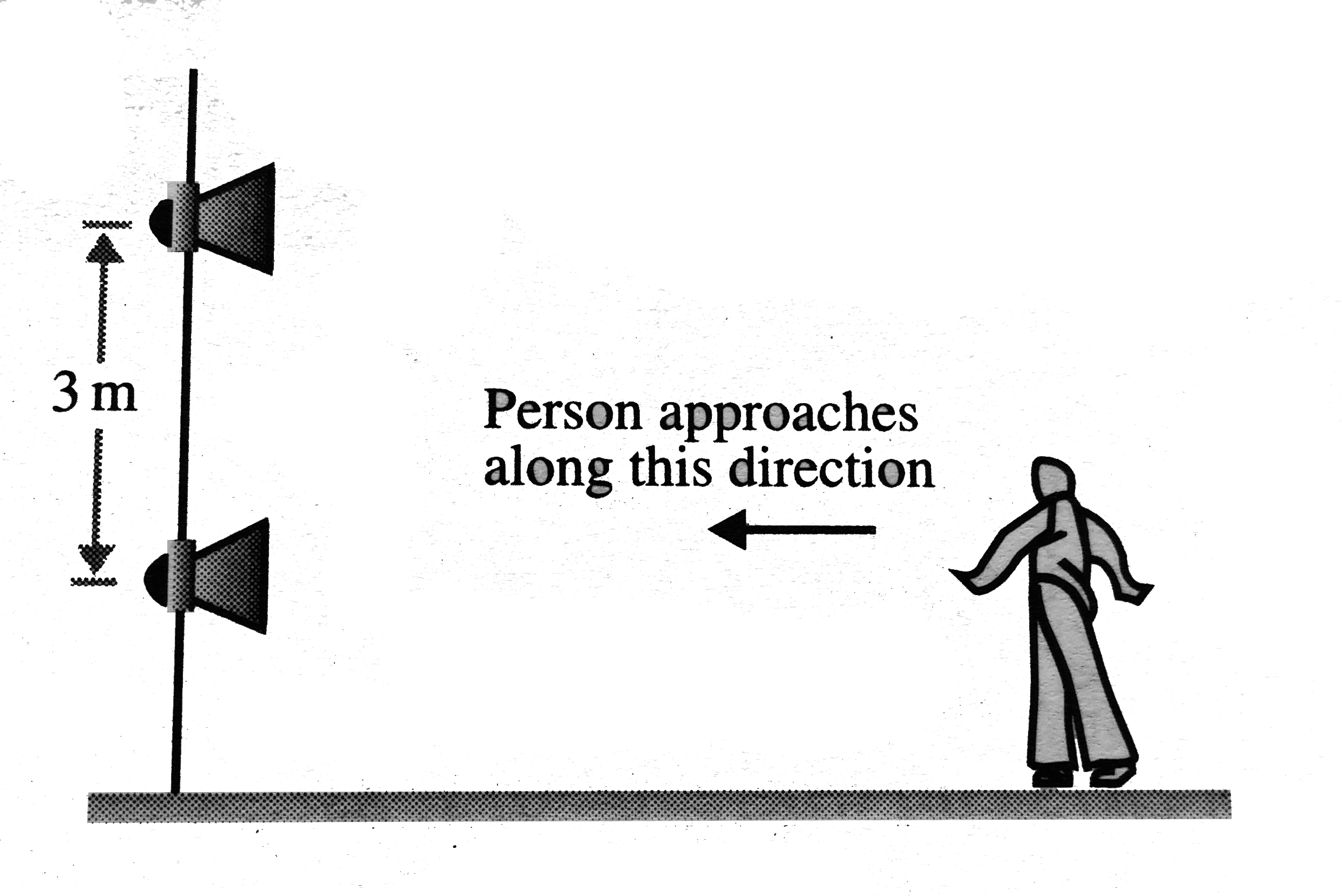
As the person walks towards the pole , his distance from the pole when he first hears a minimum in sound intensity is nearly04:02View SolutionAn oscillator of frequency `680 Hz` drives two speakers . The speakers are fixed on a vertical pole at a distance `3 m` from each other as shown in Fig. 7.103. A person whose height is almost the same as that of the lower speaker walks towards the lower speaker in a direction perpendicular to the pole. Assuming that there is no reflection of sound from the ground and speed of sound is `v = 340 m//s` , answer the following questions.

How far is the person from the pole when he hears a minimum in sound intensity a second time ?04:42View SolutionAn oscillator of frequency `680 Hz` drives two speakers . The speakers are fixed on a vertical pole at a distance `3 m` from each other as shown in Fig. 7.103. A person whose height is almost the same as that of the lower speaker walks towards the lower speaker in a direction perpendicular to the pole. Assuming that there is no reflection of sound from the ground and speed of sound is `v = 340 m//s` , answer the following questions.
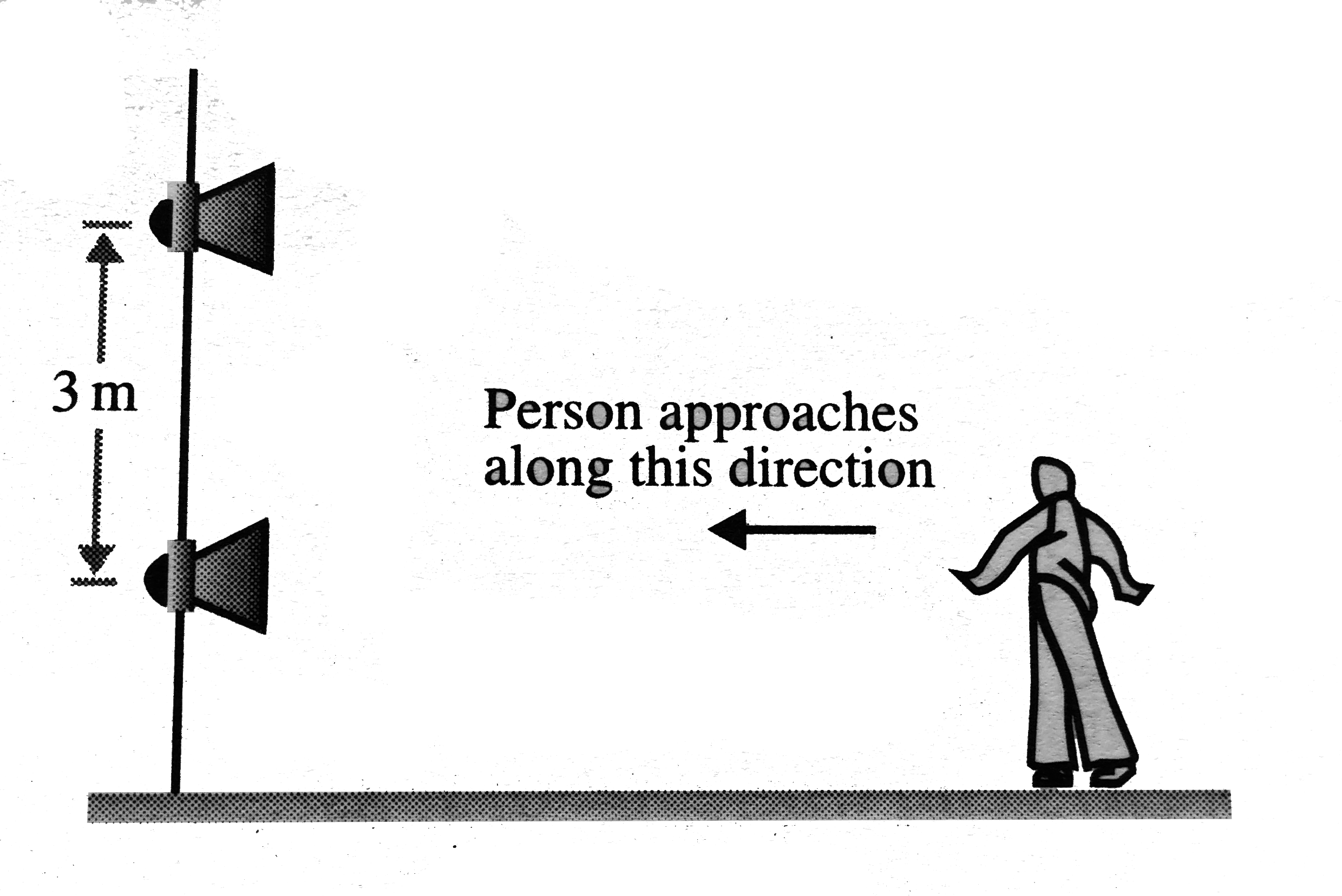
As the person walks toward the pole , the total number of times that the person hears a minimum in sound intensity will be02:11View SolutionAn oscillator of frequency `680 Hz` drives two speakers . The speakers are fixed on a vertical pole at a distance `3 m` from each other as shown in Fig. 7.103. A person whose height is almost the same as that of the lower speaker walks towards the lower speaker in a direction perpendicular to the pole. Assuming that there is no reflection of sound from the ground and speed of sound is `v = 340 m//s` , answer the following questions.
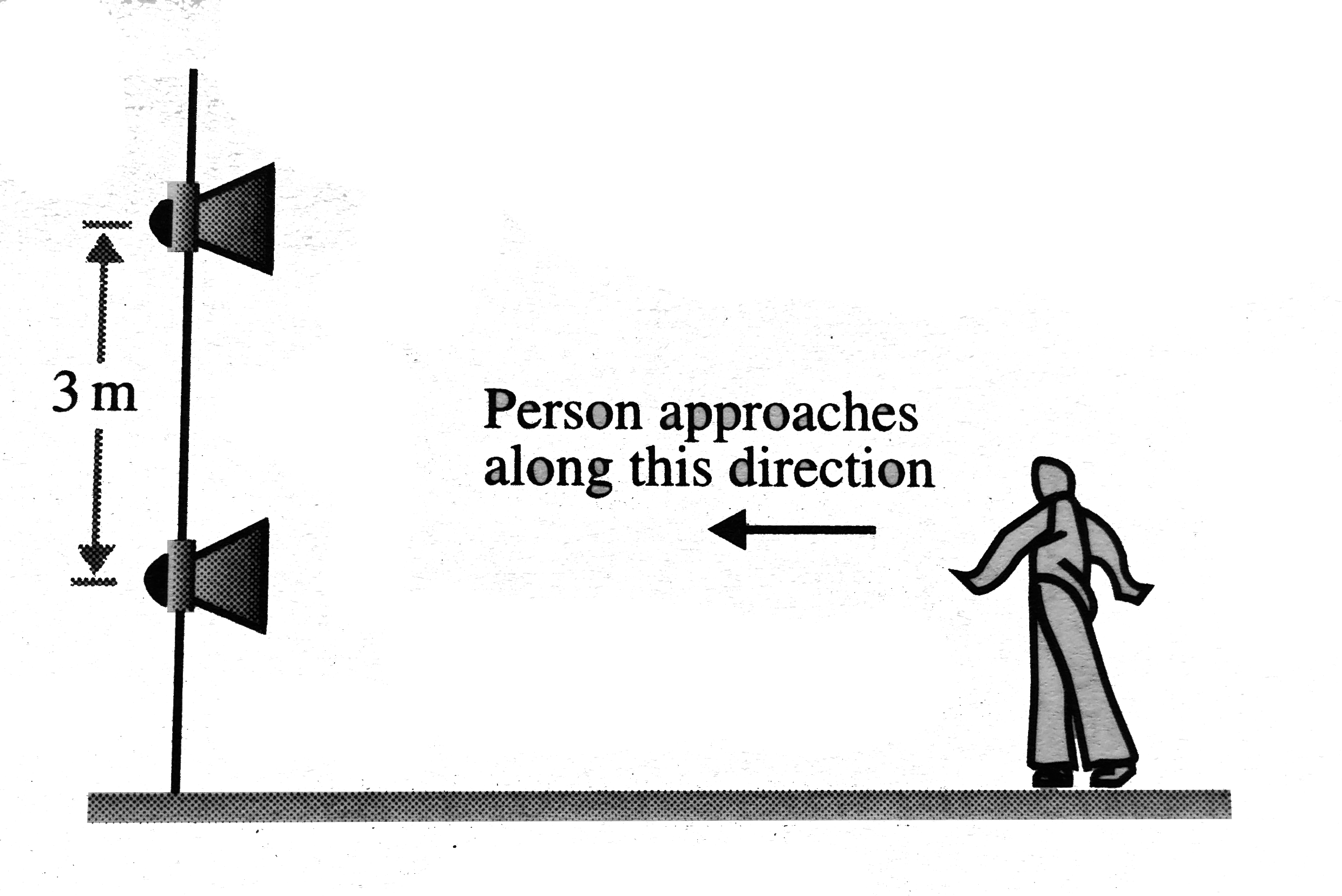
At some instant , when the person is at a distance `4 m` from the pole , the wave function ( at the person's location) that describes the waves coming from the lower speaker `y = A cos (kx - omega t)` , where `A` is the amplitude , `omega = 2 pi v` with `v = 680 Hz` (given) and `k = 2 pi//lambda`
Wave function ( at the person's location) that describes waves coming from the upper speaker can be expressed as :05:07View SolutionConsider a standing wave formed on a string . It results due to the superposition of two waves travelling in opposite directions . The waves are travelling along the length of the string in the `x` - direction and displacements of elements on the string are along the `y` - direction . Individual equations of the two waves can be expressed as
`Y_(1) = 6 (cm) sin [ 5 (rad//cm) x - 4 ( rad//s)t]`
`Y_(2) = 6(cm) sin [ 5 (rad//cm)x + 4 (rad//s)t]` Here `x` and `y` are in `cm`.
Answer the following questions.
Amplitude of simple harmonic motion of a point on the string that is located at `x = 1.8 cm` will be04:11View SolutionConsider a standing wave formed on a string . It results due to the superposition of two waves travelling in opposite directions . The waves are travelling along the length of the string in the `x` - direction and displacements of elements on the string are along the `y` - direction . Individual equations of the two waves can be expressed as
`Y_(1) = 6 (cm) sin [ 5 (rad//cm) x - 4 ( rad//s)t]`
`Y_(2) = 6(cm) sin [ 5 (rad//cm)x + 4 (rad//s)t]` Here `x` and `y` are in `cm`.
Answer the following questions.
If one end of the string is at `x = 0` , positions of the nodes can be described as04:56View SolutionConsider a standing wave formed on a string . It results due to the superposition of two waves travelling in opposite directions . The waves are travelling along the length of the string in the `x` - direction and displacements of elements on the string are along the `y` - direction . Individual equations of the two waves can be expressed as
`Y_(1) = 6 (cm) sin [ 5 (rad//cm) x - 4 ( rad//s)t]`
`Y_(2) = 6(cm) sin [ 5 (rad//cm)x + 4 (rad//s)t]` Here `x` and `y` are in `cm`.
Answer the following questions.
Amplitude of simple harmonic motion of a point on the string that is located at `x = 1.8 cm` will be04:11View SolutionConsider a standing wave formed on a string . It results due to the superposition of two waves travelling in opposite directions . The waves are travelling along the length of the string in the `x` - direction and displacements of elements on the string are along the `y` - direction . Individual equations of the two waves can be expressed as
`Y_(1) = 6 (cm) sin [ 5 (rad//cm) x - 4 ( rad//s)t]`
`Y_(2) = 6(cm) sin [ 5 (rad//cm)x + 4 (rad//s)t]` Here `x` and `y` are in `cm`.
Answer the following questions.
Figure 7.104( c) shows the standing wave pattern at `t = 0` due to superposition of waves given by `y_(1)` and `y_(2)` in Figs.7.104(a) and (b) . In Fig. 7.104 (c ) , `N` is a node and `A` and antinode . At this instant say ` t = 0` , instantaneous velocity of points on the string named as A
 02:38View Solution
02:38View SolutionA vertical pipe open at both ends is partially submerged in water . A tuning fork is unknown frequency is placed near the top of the pipe and made to vibrate . The pipe can be moved up and down and thus length of air column the pipe can be adjusted. For definite lengths of air column in the pipe, standing waves will be set up as a result of superposition of sound waves traveling in opposite directions. Smallest value of length of air column , for which sound intensity is maximum is `10 cm` [ take speed of sound , `v = 344 m//s`].
Answer the following questions.
The air column here is closed at one end because the surface of water acts as a wall. Which of the following is correct ?07:50View SolutionA vertical pipe open at both ends is partially submerged in water . A tuning fork is unknown frequency is placed near the top of the pipe and made to vibrate . The pipe can be moved up and down and thus length of air column the pipe can be adjusted. For definite lengths of air column in the pipe, standing waves will be set up as a result of superposition of sound waves travelling in opposite directions. Smallest value of length of air column , for which sound intensity is maximum is `10 cm`[ take speed of sound , `v = 344 m//s`].
Answer the following questions.
Frequency of the tuning fork is03:03View SolutionA vertical pipe open at both ends is partially submerged in water . A tuning fork is unknown frequency is placed near the top of the pipe and made to vibrate . The pipe can be moved up and down and thus length of air column the pipe can be adjusted. For definite lengths of air column in the pipe, standing waves will be set up as a result of superposition of sound waves travelling in opposite directions. Smallest value of length of air column , for which sound intensity is maximum is `10 cm`[ take speed of sound , `v = 344 m//s`].
Answer the following questions.
Length of air column for third resonance will be02:29View SolutionA vertical pipe open at both ends is partially submerged in water . A tuning fork is unknown frequency is placed near the top of the pipe and made to vibrate . The pipe can be moved up and down and thus length of air column the pipe can be adjusted. For definite lengths of air column in the pipe, standing waves will be set up as a result of superposition of sound waves travelling in opposite directions. Smallest value of length of air column , for which sound intensity is maximum is `10 cm`[ take speed of sound , `v = 344 m//s`].
Answer the following questions.
Length of air column for third resonance will be02:29View SolutionA vertical pipe open at both ends is partially submerged in water . A tuning fork is unknown frequency is placed near the top of the pipe and made to vibrate . The pipe can be moved up and down and thus length of air column the pipe can be adjusted. For definite lengths of air column in the pipe, standing waves will be set up as a result of superposition of sound waves travelling in opposite directions. Smallest value of length of air column , for which sound intensity is maximum is `10 cm`[ take speed of sound , `v = 344 m//s`].
Answer the following questions.
Frequency of the tuning fork is03:03View SolutionEstimation of frequency of a wave forming a standing wave represented by `y = A sin kx cos t` can be done if the speed and wavelength are known using `speed = "Frequency" xx "wavelength"` . Speed of motion depends on the medium properties namely tension in string and mass per unit length of string . A string may vibrate with different frequencies . The corresponding wavelength should be related to the length of the string by a whole number for a string fixed at both ends . Answer the following questions:
Speed of a wave in a string forming a stationary wave does not depend on01:46View SolutionEstimation of frequency of a wave forming a standing wave represented by `y = A sin kx cos t` can be done if the speed and wavelength are known using `speed = "Frequency" xx "wavelength"` . Speed of motion depends on the medium properties namely tension in string and mass per unit length of string . A string may vibrate with different frequencies . The corresponding wavelength should be related to the length of the string by a whole number for a string fixed at both ends . Answer the following questions:
If `y = 10 sin 5 x cos 2 t m` represents a stationary wave then , the possible one of the travelling waves causing this is02:16View SolutionEstimation of frequency of a wave forming a standing wave represented by `y = A sin kx cos t` can be done if the speed and wavelength are known using `speed = "Frequency" xx "wavelength"` . Speed of motion depends on the medium properties namely tension in string and mass per unit length of string . A string may vibrate with different frequencies . The corresponding wavelength should be related to the length of the string by a whole number for a string fixed at both ends . Answer the following questions:
A string fixed at both ends having a third overtone frequency of `200 Hz` while carrying a wave at a speed of `30 ms^(-1)` has a length of01:41View SolutionIn an organ pipe (may be closed or open ) of `99 cm` length standing wave is set up , whose equation is given by longitudinal displacement.

`xi = (0.1 mm) cos ( 2pi)/(0.8) (y + 1 cm) cos (400) t`where `y` is measured from the top of the tube in `metres` and `t "in" seconds` . Here `1 cm` is the end correction.
The air column is vibrating in03:11View SolutionIn an organ pipe ( may be closed or open of `99 cm` length standing wave is setup , whose equation is given by longitudinal displacement `xi = (0.1 mm) cos ( 2pi)/( 0.8) ( y + 1 cm) cos 2 pi (400) t`
where `y` is measured from the top of the tube in metres and `t` in second. Here `1 cm` is th end correction.

The air column is vibrating in04:48View SolutionIn an organ pipe ( may be closed or open of `99 cm` length standing wave is setup , whose equation is given by longitudinal displacement `xi = (0.1 mm) cos ( 2pi)/( 0.8) ( y + 1 cm) cos 2 pi (400) t`
where `y` is measured from the top of the tube in metres and `t` in second. Here `1 cm` is th end correction.
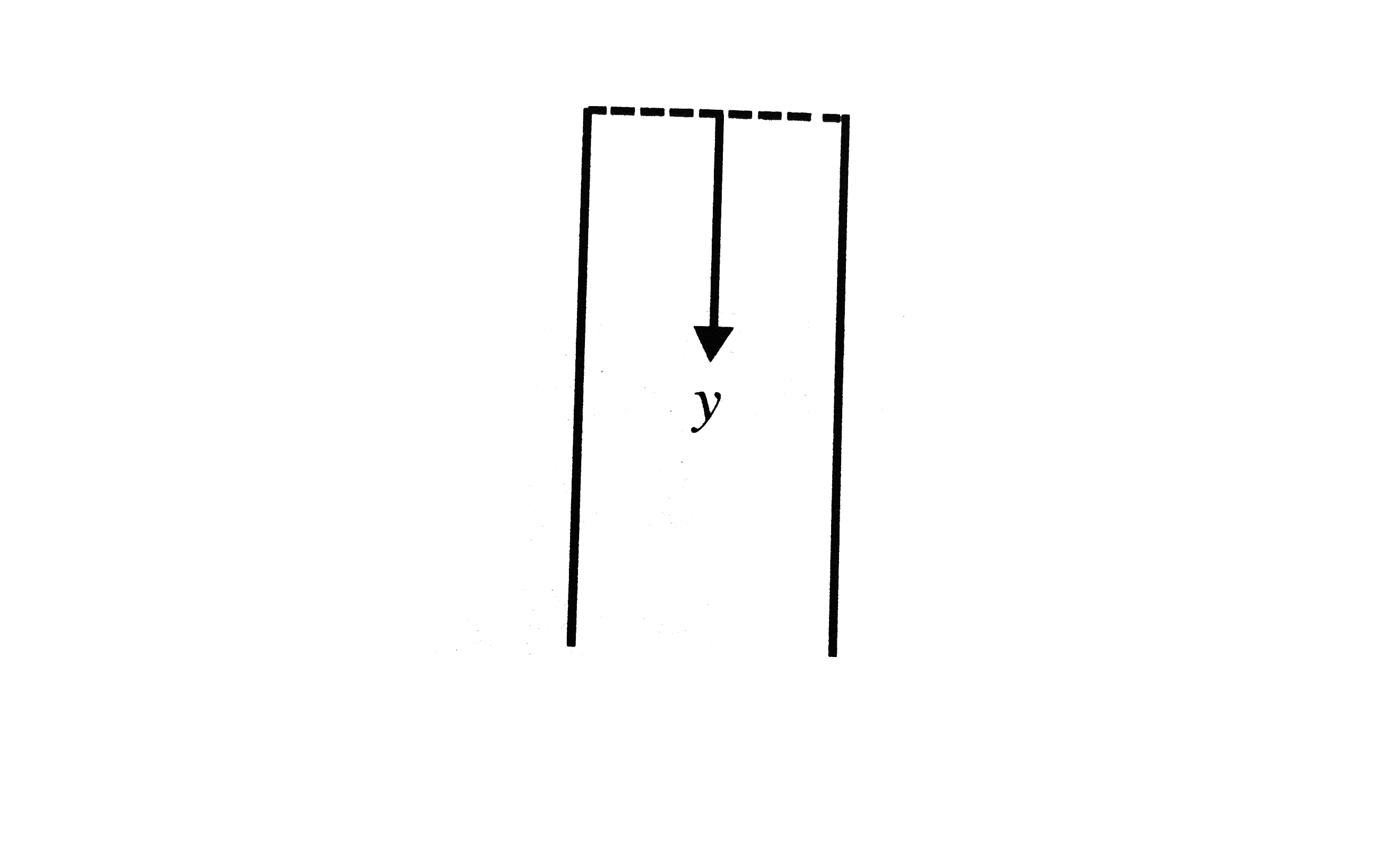
Equation of the standing wave in terms of excess pressure is -
(Bulk modulus of air `B = 5 xx 10^(5) N//m^(2)`)View SolutionIn an organ pipe ( may be closed or open of `99 cm` length standing wave is setup , whose equation is given by longitudinal displacement `xi = (0.1 mm) cos ( 2pi)/( 0.8) ( y + 1 cm) cos 2 pi (400) t`
where `y` is measured from the top of the tube in metres and `t` in second. Here `1 cm` is th end correction.

Assume end correction approximately equals to `(0.3) xx`(diameter of tube) , estimate the moles of air pressure inside the tube (Assume tube is at `NTP` , and at `NTP , 22.4 litre` contain `1 mole`)02:53View Solution
Comprehension questions and complete solutions for chapter SUPERPOSITION AND STANDING WAVES of CENGAGE PHYSICS (ENGLISH) of Class 11
